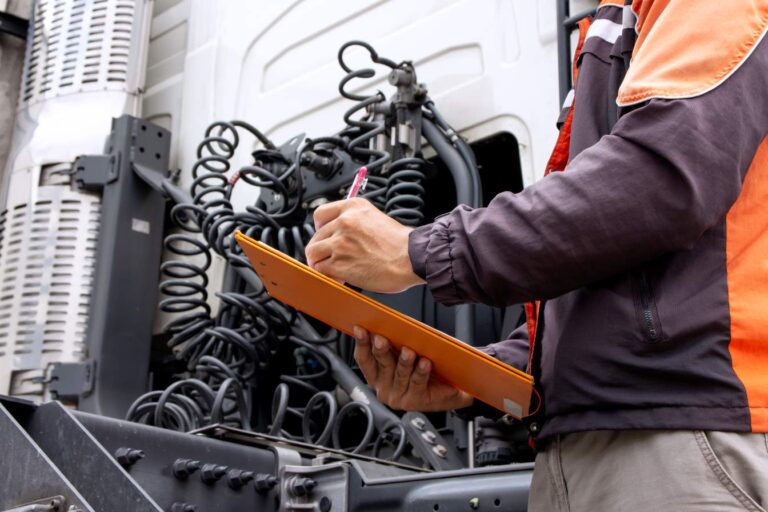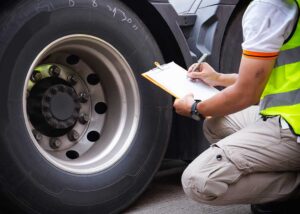Many drivers dread entering weigh stations — but not because of the scales. (Hopefully, they’ve already weighed their trucks and made the necessary adjustments so they know they’re running legal.)
It’s that lighted arrow pointing to the inspection area, or the words “pull it around back” emanating from a speaker that can generate fear, or at least impatience, in every driver. No driver ever says, “Yes! An inspection!”
Keep in mind, though, that these inspections are critical to keeping the trucking industry rolling safely down the road. Inspection data shows the justification for continued inspections.
During the Commercial Vehicle Safety Alliance’s (CVSA) 2023 Roadcheck inspection blitz, 59,429 vehicles were inspected. Nineteen percent of those vehicles — that’s nearly one in five — were found to have out-of-service (OOS) defects. Another 5.5% of the drivers inspected were found to have OOS violations.
It’s important to note that the CVSA’s 72-hour Roadcheck inspection is always announced well in advance, focus areas are publicized, and information about what to check and how to pass an inspection is distributed.
The 2023 Roadcheck was not a surprise — yet almost one in five trucks failed.
Who’s in charge?
Most drivers don’t know who performs these inspections and who sets the rules. While just about any law enforcement officer can check a driver’s paperwork or issue a citation for equipment defects, the CVSA sets the inspection standard.
What is CVSA? In a nutshell, it’s a nonprofit organization that includes local, state, provincial, territorial and federal commercial motor vehicle (CMV) safety officials and industry representatives. The mission of the group is to prevent CMV crashes, injuries and fatalities by providing guidance and education for the trucking industry and enforcement agencies.
This partnership between government and industry helps make sure the same standards are used across North America to determine the safety of CMVs.
When CVSA-qualified inspectors check an item, they’re following CVSA guidelines for determining what a defect is and whether it should put the driver or vehicle OOS. The organization determines what gets inspected, how it’s inspected, what constitutes a violation and when the vehicle or driver should be placed out of service.
During CVSA’s fiscal year 2023 (Oct. 1, 2022-Sept. 30, 2023), the group says nearly 4 million inspections were conducted in North America, with more than 1.3 million decals indicating “no critical defects found” were issued. More than 16,000 copies were sold of CVSA’s North American Standard Out-Of-Service Criteria books in printed and electronic form. Training is accomplished through in-person events, meetings and conferences and webinars. Inspectors are certified for different levels of inspection.
Wait. There are inspection levels?
CVSA conducts eight levels of inspection. Which inspection is performed can depend on available inspectors, the cargo and other considerations.
- Level I is the classic “everything” inspection. Driver documents such as CDL, medical card and Skill Performance Certificate are checked, along with the record of duty status, vehicle inspection reports and seat belt use. A complete vehicle inspection is included. (Note: A Level I inspection includes the items from Level III and Level V inspections.)
- Level II is a walk-around inspection of the vehicle, checking systems that can be observed without crawling underneath, as well as all of the driver documents.
- Level III inspections deal with the driver’s credentials. When the driver is instructed to bring paperwork into the weigh station office, it’s often for a Level III inspection. Vehicle documents, such as registration and authority, can be checked. With electronic logs (ELDs), inspectors may go to the vehicle or may request faxed or electronic copies of the driver’s record-of-duty status.
- Level IV inspections are conducted for special purposes, such as a government study of a particular item or document.
- Level V inspections are thorough checks of the vehicle. The driver does not need to be present. These can be conducted where the truck is parked or abandoned.
- Level VI inspections involve radioactive materials classified as waste or route-controlled quantities. Most drivers will never experience this level of inspection.
- Level VII are jurisdictional in nature, usually specified by a government agency. For example, a county might mandate that all school buses in the county must be checked for broken windshields. A full inspection may not be necessary, and CVSA certified instructors are not required.
- Level VIII inspections are electronic and could be conducted without the driver being aware. Records such as the driver’s CDL and medical card, registration, duty status and more can be wirelessly checked without stopping the vehicle.
If the vehicle portion of a Level I or Level V inspection is passed with no critical violations, a CVSA decal may be placed on the vehicle. The decal must be placed by a certified instructor and is valid for three months.
A vehicle bearing the CVSA decal generally won’t be inspected again until the decal expires … but there are no guarantees. If an inspector notices something that should be checked, if the vehicle breaks down or if the jurisdiction is checking trucks that meet specific criteria, an inspection can be conducted regardless of whether the vehicle has a sticker.
Is the CVSA out to “get” drivers?
While being chosen for an inspection can be inconvenient and anxiety inducing, it’s important to remember that the CVSA is there to look out for the interests of everyone, including you.
While it’s true that lives have been saved by removing unsafe trucks from the road, there’s another way to look at it: Inspections often catch problems before they escalate to critical or OOS status, providing the truck owner with the opportunity to make repairs before an expensive breakdown (or a crash) can occur.
Inspections also help educate drivers on what to look for in pre-trip inspections and alert them to what they might be missing. That makes everyone safer and, from a business perspective, helps truck owners keep maintenance costs down.
In short, the CVSA serves as a partnership that brings together motor carriers, vehicle manufacturers, law enforcement — and, of course, drivers.
Cliff Abbott is an experienced commercial vehicle driver and owner-operator who still holds a CDL in his home state of Alabama. In nearly 40 years in trucking, he’s been an instructor and trainer and has managed safety and recruiting operations for several carriers. Having never lost his love of the road, Cliff has written a book and hundreds of songs and has been writing for The Trucker for more than a decade.







